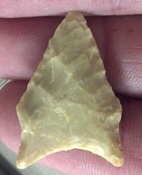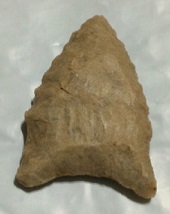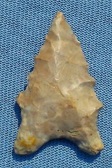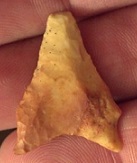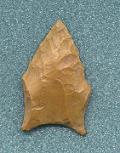Outline is Representative of Size and Shape:

Name Details:
Identified By: Clarence Webb
Named For:
Date Identified: 1943
Type Site:
Identified By: Clarence Webb
Named For:
Date Identified: 1943
Type Site:
Point Validity:
Valid type
Webb was a trained Pediatrician who became interested in archeology. In 1940 he became the charter member of the Society of American Archeology. He conducted many collaborative excavations and conducted his own excavations at Poverty Point and Gahagan Mounds. He was a well-respected archaeologist. He named this point in a professional publication and this type has many professional references. This is a valid type.
San Patrice Hope Variety
AKA: HopeCluster: San Patrice Cluster
Description of Physical Characteristics and Flaking Pattern:
This is a small thin auriculate point with a flattened cross section. The blade may vary from slightly excurvate to straight. The shoulders may range from weak to absent, or may be well defined. The shoulders are at an upward angle. Broad notches form a long stem that is expanding stem. The base is deeply concave forming auricle. The base is thinned by removal of two or three channel flakes which extends up to the face of the point. This point has a random flaking pattern.
Size Measurements:
Total Length - 20 to 50 mm (average 35 mm), Stem Length - 9 to 18 mm, Blade Width - 20 to 32 mm, Neck Width - 15 to 25 mm, Basal Width - Same or slightly narrower than shoulders, Fluted 1/3 to 2/3 length of point (Suhm and Krieger, 1954).
Total Length - 20 to 50 mm (average 35 mm), Stem Length - 9 to 18 mm, Blade Width - 20 to 32 mm, Neck Width - 15 to 25 mm, Basal Width - Same or slightly narrower than shoulders, Fluted 1/3 to 2/3 length of point (Suhm and Krieger, 1954).
Commonly Utilized Material:
Additional Comments:


Distribution: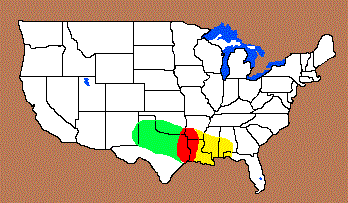
Distribution Comments:
San Patrice points are most concentrated in the western Gulf Coastal Plains (red) and decrease into the eastern Gulf Coastal Plains (yellow). San Patrice points are reported into central Texas, most commonly St. Johns, Hope, and Rodgers Side Hollow (Brazo Fishtail) types (green). Hurst et al. (2009) reports Hope and St. John's variants at the Hardwick site in Roosevelt County, New Mexico. which is included in the green area.
San Patrice points are most concentrated in the western Gulf Coastal Plains (red) and decrease into the eastern Gulf Coastal Plains (yellow). San Patrice points are reported into central Texas, most commonly St. Johns, Hope, and Rodgers Side Hollow (Brazo Fishtail) types (green). Hurst et al. (2009) reports Hope and St. John's variants at the Hardwick site in Roosevelt County, New Mexico. which is included in the green area.
Age / Periods:
Date: 10,000 - 8,000 B.P.
Cultural Period: Transitional Paleo to Early Archaic
Glacial Period: Early Holocene
Culture:
Date: 10,000 - 8,000 B.P.
Cultural Period: Transitional Paleo to Early Archaic
Glacial Period: Early Holocene
Culture:
Age Details:
Similar Points:
Dalton, Kisatchie, Palmer, Pelican, Rodgers Side Hollow, San Patrice, San Patrice Keithville, San Patrice Geneill, San Patrice Leaf River, San Patrice St. Johns
Dalton, Kisatchie, Palmer, Pelican, Rodgers Side Hollow, San Patrice, San Patrice Keithville, San Patrice Geneill, San Patrice Leaf River, San Patrice St. Johns
Other points in this cluster / Related / Associated Points:
Albany, San Patrice, San Patrice Geneill, San Patrice Keithville, San Patrice Kisatchie, San Patrice Leaf River, San Patrice St. Johns
Albany, San Patrice, San Patrice Geneill, San Patrice Keithville, San Patrice Kisatchie, San Patrice Leaf River, San Patrice St. Johns



